About Falcons
5 Life Cycle
Lauren Weiss
Age
Peregrine falcons generally live about 10 years. One of the longest known living peregrines lived to be 17 years old. This was the second male who occupied the Customs House tower territory in downtown Boston, and he raised 50 chicks.
Peregrine falcons are considered adults after their first molt, usually around 13 months of age. Molting is when a bird loses its old feathers and grows new ones to replace them. For falcons, this happens during and after the breeding period in spring and summer.
Nesting
Most peregrines first nest (find a mate and territory and raise chicks) at 2-3 years old.
Mating
Peregrines mate for life but will find a new mate if their current one is replaced by a challenger or passes away.
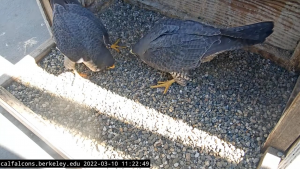
To attract a mate, falcons will perform a courtship display: a series of behaviors including head bows (they bow their heads low to each other), aerial displays, scraping of the ground, and beaking (playfully nipping at each other). These behaviors continue throughout nesting to strengthen the connection between the mates; this is called pair bonding.
Egg Laying
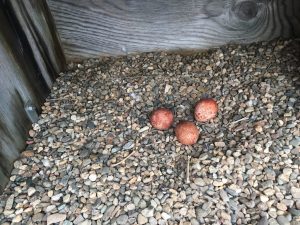
Before laying, females may become lethargic (very tired and sluggish) and spend a lot of time alone in the nest, scraping out the depression for the eggs. Females usually lay 3-5 eggs, called a clutch, in early spring. Eggs are pinkish to brownish in color and approximately 2 inches long, a little smaller than a chicken egg.
Incubation
Incubation means sitting on the eggs to keep them warm so they can develop and hatch. Peregrine falcon eggs have an incubation period of approximately 33-35 days.
Hard incubation (constant incubation) doesn’t start until the second-to-last egg is laid, which ensures that all the chicks will develop and hatch around the same time.
The female peregrine falcon does most of the incubation. The male will also take turns incubating the eggs so the female can stretch her wings, but his primary job during incubation is hunting and providing food for the female.
During incubation, adult falcons will pull, push, roll, and rotate the eggs around underneath them so that they develop properly. The scientists at UC Berkeley who monitor the peregrines nesting on the Campanile call this enfluffeling.
To keep the eggs warm during incubation, falcons develop something called a brood patch. This is an area on their bellies that loses feathers after egg-laying and develops additional blood vessels close to the surface so that the patch is nice and warm in direct contact with the eggs.
Hatching
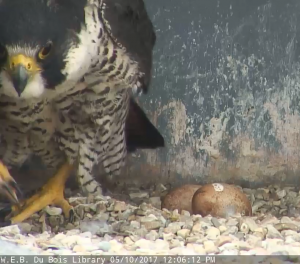
After the incubation period, the chicks are ready to hatch. A pip develops in the egg, which is the first hole in the egg made by the chick using its egg tooth (a temporary sharp tooth-like projection on the beak), allowing it to breathe outside air for the first time. It takes approximately 24-48 hours for a chick to hatch after pipping. During that time, the female falcon will chirp to the chicks in the eggs to encourage them to hatch.
Chicks
A peregrine falcon chick is also called an eyas/eyass (EYE-us) (plural: eyases/eyasses). When it hatches, a chick can also be referred to as a hatchling or nestling.
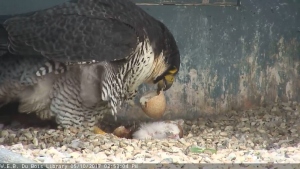
Newly-hatched peregrine falcons are very small and only weigh about 1.5 oz. They are covered in white down (fluff). According to the scientists at UC Berkeley, due to their small size, “there is relatively more surface area than in a large animal, resulting in more heat lost through the skin than is created by the body.” That is why adult peregrines will continue to incubate the chicks for about 10 days after they hatch until the chicks are large enough to generate more heat than they lose and control their own body temperatures, or thermoregulate themselves.
Peregrine falcon chicks develop incredibly quickly. From hatching at 1.5 oz, they double their weight in just 6 days, and increase tenfold in 3 weeks.
Like human babies, peregrine falcon chicks cannot walk right away. Instead, they scoot around on their tarsi (parts of their legs between backwards “knee” and ankle”; single: tarsus) until their legs are strong enough for them to stand up and walk.
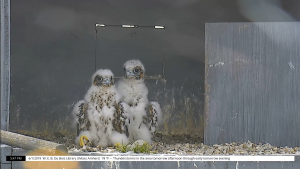
When the chicks are 21-35 days old, feathers grow in and replace the white down. They grow brown juvenile feathers that will be replaced by the gray adult feathers after their first molt.
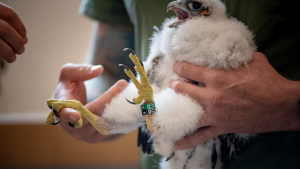 21-35 days is also when wildlife experts may band them before they grow too big and start to fly. Banding is when wildlife experts put specially colored, numbered and lettered metal bands around a chick’s legs. These bands do not hurt the chicks; it’s like wearing jewelry! The colors, numbers, and letters on the bands help the experts and other birdwatchers identify the chicks as they grow and eventually leave the nest.
21-35 days is also when wildlife experts may band them before they grow too big and start to fly. Banding is when wildlife experts put specially colored, numbered and lettered metal bands around a chick’s legs. These bands do not hurt the chicks; it’s like wearing jewelry! The colors, numbers, and letters on the bands help the experts and other birdwatchers identify the chicks as they grow and eventually leave the nest.
Fledging
As they get older, the chicks start to explore the environment around their nest, often climbing around on top of objects. This is called branching. Although peregrine falcons don’t nest in trees, and, therefore, branches, the term was coined by birdwatchers who observed other raptors that did, and just decided to apply it to this behavior done by all raptors.
Once their feathers come in, they also start doing a lot of flapping exercises (jokingly called “flappercize” or “wingercize”) to strengthen their wing muscles so they can get ready to fly. They will start taking short hopping flights around the nest site.
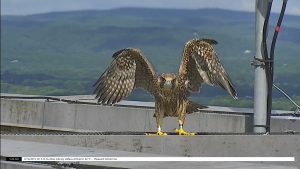
When they are approximately 7 weeks old, the chicks reach adult size and fledge (fly). Once they do, they are called fledglings. To start off, they follow their parents around while flying. The parents begin giving them their food through mid-air prey exchanges and teach them to hunt.
Approximately 2 months later, the fledglings become independent of their parents and leave the nest.
Media Attributions
- Courtship Display: Head Bows © Cal Falcons - University of California Berkeley is licensed under a CC BY (Attribution) license
- Thompson Nest Box_Pink eggs © UMass Amherst Libraries is licensed under a CC BY (Attribution) license
- Pip © UMass Amherst Libraries is licensed under a CC BY (Attribution) license
- Newly Hatched Peregrine Chick © UMass Amherst Libraries is licensed under a CC BY (Attribution) license
- Peregrine falcon chicks with feathers growing in. © UMass Amherst Libraries is licensed under a CC BY (Attribution) license
- Banding Day 2022 © Samm Smith is licensed under a CC BY (Attribution) license
- Juvenile Peregrine Falcon 77/BV is licensed under a CC BY (Attribution) license

